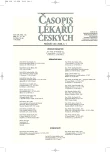Acute Toxicity of High Dose Interstitial Brachytherapy Boost in Prostate Cancer
Akutní nežádoucí účinky brachyterapie s vysokým dávkovým příkonem v kombinaci se zevní radioterapií u lokalizovaného karcinomu prostaty
Východisko.
V posledních letech se v léčbě karcinomu prostaty stále více využívá brachyterapie. Podíl brachyterapie na léčbě lokalizovaných karcinomů prostaty roste díky nízkým akutním i pozdním nežádoucím účinkům. Na druhé straně brachyterapie umožňuje zvyšování dávky záření výrazně zlepšující léčebné výsledky.
Metody a výsledky.
Kombinace zevní radioterapie a brachyterapie s vysokým dávkovým příkonem byla použita u 40 pacientů s lokalizovaným karcinomem prostaty T1c-T3a od srpna 2004 do června 2005. Všichni pacienti podstoupili transperinální konformní HDR brachyterapii (2 frakce, 8 Gy na frakci) a zevní radioterapii na oblast pánve nebo prostaty a semenných váčků v dávce 45–50,4 Gy. Pacienti byli rozděleni do tří skupin dle vstupního PSA, Gleason skóre a T klasifikace: skupina nízkého rizika (11 pacientů – 27,5 %), středního rizika (14 pacientů – 35 %) a vysokého rizika rekurence (15 pacientů – 37,5 %). Průměrný věk byl 68,7 let (55–77). Hormonální manipulace byla provedena u 17 pacientů – 42,5 %. U všech pacientů jsme hodnotili akutní toxicitu léčby dle RTOG kritérií. Všichni pacienti před a po léčbě vyplňovali IPSS dotazník mezinárodního skóre prostatických symptomů. Akutní genitourinární toxicita stupně 1 byla zaznamenána u 37,5 %, stupně 2 u 15 % pacientů. Stupně 3–4 u jednoho pacienta (2,5 %). K úpravě symptomů spojených s léčbou došlo dle IPSS dotazníku u většiny pacientů (90 %) do jednoho měsíce od skončení léčby. Akutní gastrointestinální toxicita byla zaznamenána pouze stupně 1 u 40 % pacientů.
Závěry.
V našem souboru jsme prokázali velmi dobrou toleranci kombinované zevní radioterapie a HDR brachyterapie v léčbě karcinomu prostaty. Akutní toxicita byla nízkého stupně. Jako rizikové faktory pro akutní genitourinární toxicitu jsme vyhodnotili objem prostaty a pro gastrointestinální toxicitu především kombinaci s ozářením pánve a hormonální léčbou.
Klíčová slova:
brachyterapie s vysokým dávkovým příkonem, brachyterapie, lokalizovaný karcinom prostaty, akutní nežádoucí účinky.
Authors:
R. Soumarová; L. Homola; M. Štursa 1; H. Perková
Authors‘ workplace:
Onkologické centrum J. G. Mendela, Nový Jičín
; Urologické oddělení nemocnice Nový Jičín
1
Published in:
Čas. Lék. čes. 2006; 145: 43-49
Category:
Original Article
Overview
Background.
Over the past few years, brachytherapy has become more and more common in the treatment of prostate cancer. Part of the reason behind this growth in the use of brachytherapy for the treatment of organ-confined prostate cancer is the reduced amount of acute and chronic side effects. On the other hand, brachytherapy allows for dose escalation, resulting in significant improvements in the treatment results.
Method and Results.
From August 2004 to June 2005, we irradiated 40 patients with T1c-T3a prostate cancer. All of the patients underwent transperineal transrectal guided high dose rate (HDR) brachytherapy (two fractions, 8 Gy per fraction) and course of external beam radiotherapy with a median dose of 45–50.4 Gy. The patients were classified into three groups: low risk of recurrence (11 patients – 27.5 %), medium risk (14 patients – 35 %) and high risk (15 patients – 37.5 %). The medium age of the patients was 68.7 years (range of between 55 and 77). Hormonal treatment was carried out with 17 of the patients (42.5 %). We evaluated the quality of each implantation, including the maximum urethral and rectal dose. The calculated doses were compared with measurements by in vivo dosimetry. Acute toxicity was evaluated in all of the patients according to the Radiation Therapy Oncology Group (RTOG) scale. Each of the patients completed an International Prostatic Symptom Score (IPSS) questionnaire. Acute genitourinary morbidity grade 1 was recorded in 37.5 % of patients, and grade 2 in 15 % of patients. Urine retention in one of the patients resulted in the need to perform an epicystostomy. According to the IPSS score, the majority of patients (90 %) experienced an improvement in symptoms related to quality of life. Grade 1 acute gastrointestinal toxicity was recorded in 40 % of the patients. Grades 2-4 were not recorded.
Conclusions.
We showed that the combination of external beam radiotherapy and HDR brachytherapy in the treatment of early prostate cancer to be feasible and well tolerated. Acute toxicity was low and scarcely influenced the quality of life. Among the risk factors of genitourinary toxicity was the volume of the prostate. For gastrointestinal toxicity, risk factors included a combination of HDR brachytherapy and external beam radiotherapy to the pelvis, as well as hormonal treatment.
Key words:
high dose rate brachytherapy, organ-confined prostate cancer, acute toxicity.
Labels
Addictology Allergology and clinical immunology Angiology Audiology Clinical biochemistry Dermatology & STDs Paediatric gastroenterology Paediatric surgery Paediatric cardiology Paediatric neurology Paediatric ENT Paediatric psychiatry Paediatric rheumatology Diabetology Pharmacy Vascular surgery Pain management Dental HygienistArticle was published in
Journal of Czech Physicians

- Metamizole at a Glance and in Practice – Effective Non-Opioid Analgesic for All Ages
- Metamizole vs. Tramadol in Postoperative Analgesia
- Possibilities of Using Metamizole in the Treatment of Acute Primary Headaches
- Metamizole in the Treatment of Acute Postoperative Pain
- Current Insights into the Antispasmodic and Analgesic Effects of Metamizole on the Gastrointestinal Tract
Most read in this issue
- Impact Factor – Good Servant, but a Bad Master
- Acute Toxicity of High Dose Interstitial Brachytherapy Boost in Prostate Cancer
- Abuse of Buprenorphine Becomes a Problem of the Czech Republic
- Principle and Importance of Using the Array CGH in Hematooncology
